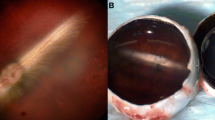Summary
Physico-chemical methods (viscosity-, molecular weight and refractive index measurements) were used to obtain a suitable 1 % maximally swollen polyacrylamide gel for vitreous implantation. The removal of toxic monomers was followed by UV-spectroscopic measurements of dialysates.
Intravenous administration of polyacrylamide in 30 rabbits was systemically well tolerated, and no immunological reactions were found. Experiments with tritium-labelled polyacrylamide injected into the vitreous cavity of 40 eyes showed 55% of retained activity present four weeks after injection. Intravitreal polyacrylamide in 60 other eyes was well tolerated, as shown by biomicroscopy, ultrasonography and histology. It remained clear until the animals were sacrificed after 14 months. Clearing of the vitreous was achieved in 26 of 60 eyes when hemorrhagic vitreous was replaced with polyacrylamide.
Polyacrylamide has been shown to be a well-tolerated vitreous substitute.
Zusammenfassung
Zur Erhaltung eines zur Glaskörperimplantation geeigneten, l % igen, maximal gequollenen Polyacrylamid-Gels wurden physikalisch-chemische Methoden (Viscositäts-, Molekulargewichts- und Brechungsindexmessungen) angewandt. Die Entfernung von Restmonomeren wurde durch UV-spektroskopische Messungen an Gel-Dialysaten nachgewiesen.
Intravenöse Verabreichung von Polyacrylamid bei 30 Kaninchen wurde gut toleriert, immunologische Abwehrreaktionen waren nicht nachweisbar. Experimente mit Tritium-markierten Polyacrylamid-Lösungen, welche in den Glaskörperraum von 40 Augen injiziert wurden, zeigten, daß noch 55% der Aktivität nach 4 Wochen vorhanden war. Intravitreale Injektion von Polyacrylamid-Gelen in 60 Augen wurden gut vertragen, wie sich biomikroskopisch, ultrasonographisch und histologisch nachweisen ließ. Die Implantate blieben klar bis zur Enucleation der behandelten Augen nach 14 Monaten. Aufhellung des vorher durch intravitreale Eigenblut-Injektion eingetrübten Glaskörpers wurde in 26 von 60 Augen erreicht.
Polyacrylamid wird als ein gut verträgliches Glaskörperimplantat angesehen.
Similar content being viewed by others
References
Balazs, E. A.: Molecular morphology of the vitreous body. New York-London: Academic Press 1961
Balazs, E. A.: Die Mikrostruktur und Chemie des Glaskörpers. Ber. dtsch. ophthal. Ges. 68, 536 (1967)
Balazs, E. A.: The biological effect of healon in the vitreous. Eighth meeting Club Jules Gonin, Miami, Florida: in Press 1972
Borduras, A., Grabar, P.: Zit. by A. J. Crowle, Immunodiffusion. New York-London: Academic Press 1961. Ann. Inst. Pasteur 84, 903 (1953)
Cockerham, W. D., Schepens, C. L., Freeman, H. M.: Silicone injection in retinal detachment. Arch. Ophthal. 83, 704 (1970)
Daniele, S., Refojo, M. F., Schepens, C. L., Freeman, H. M.: Glyzeryl methacrylate hydrogel as a vitreous implant. Arch. Ophthal. 80, 120 (1968)
Dohlman, C. H., Refojo, M. F., Webster, E. G., Pfister, R. R., Doane, M. G.: Tension intraoculaire sous corps ciliaire. Arch. Ophtal. (Paris) 29, 849 (1969)
Gärtner, J.: Elektronenmikroskopische Untersuchungen über Glaskörperrindenzellen und Zonulafasern. Z. Zellforsch. 66, 737 (1965)
Lund, O.-E.: Siliconöl als Glaskörperersatz. Ber. dtsch. ophthal. Ges. 68, 166 (1967)
Machemer, R.: A new concept for vitreous surgery. 2. Surgical technique and complications. Amer. J. Ophthal. 14, 1022 (1972)
Machemer, R., Norton, E. W. D.: A new concept for vitreous surgery. 3. Indications and results. Amer. J. Ophthal. 14, 1034 (1972)
Müller-Jensen, K., Klein, J., Bauer-Stäb, G.: Untersuchung über die Eignung von polymerem Acrylamid als Glaskörperersatz. II. Mitteilung. Ber. dtsch. ophthal. Ges. 69, 530 (1967)
Müller-Jensen, K., Köhler, H.: Versuch eines Glaskörperersatzes durch Polyacrylamid. Ber. dtsch. ophthal. Ges. 68, 181 (1967)
Okun, E.: Therapy of retinal detachment complicated by massive pre-retinal fibroplasia. Ber. dtsch. ophthal. Ges. 68, 150 (1967)
Ouchterlony, Ö.: Progr. Allergy 5, 1 (1958). Zit. by A. J. Crowle, Immunodiffusion. New York-London: Academic Press 1961
Swann, D. A., Constable, J.: Vitreous structure. I. Distribution of hyaluronase and protein. Invest. Ophth. 11, 159 (1972)
Swann, D. A., Constable, J., Harpers, J.: Vitreous structure. III. Composition of bovine vitreous collagen. Invest. Ophth. 11, 735 (1972)
Teng, C. C.: An electron microscopic study of cells in the vitreous of the rabbit eye. I. The macrophage. E.E.N.T. Monthly 48, 46 (1969)
Author information
Authors and Affiliations
Rights and permissions
About this article
Cite this article
Mueller-Jensen, K. Polyacrylamide as an alloplastic vitreous implant. Albrecht von Graefes Arch. Klin. Ophthalmol. 189, 147–158 (1973). https://doi.org/10.1007/BF00417748
Received:
Issue Date:
DOI: https://doi.org/10.1007/BF00417748



